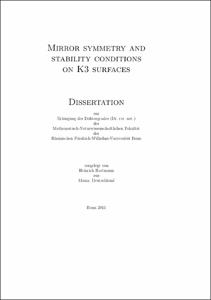Hartmann, Heinrich: Mirror symmetry and stability conditions on K3 surfaces. - Bonn, 2011. - Dissertation, Rheinische Friedrich-Wilhelms-Universität Bonn.
Online-Ausgabe in bonndoc: https://nbn-resolving.org/urn:nbn:de:hbz:5N-25986
Online-Ausgabe in bonndoc: https://nbn-resolving.org/urn:nbn:de:hbz:5N-25986
@phdthesis{handle:20.500.11811/5012,
urn: https://nbn-resolving.org/urn:nbn:de:hbz:5N-25986,
author = {{Heinrich Hartmann}},
title = {Mirror symmetry and stability conditions on K3 surfaces},
school = {Rheinische Friedrich-Wilhelms-Universität Bonn},
year = 2011,
month = jul,
note = {This thesis is concerned with questions arising in the realm of mirror symmetry for K3 surfaces. It is divided into two parts.
In the first part, we study the bijection between Fourier–Mukai partners of a K3 surface X and cusps of the Kähler moduli space which was established by Shouhei Ma in [Ma09]. The Kähler moduli space can be described as a quotient of Bridgeland’s manifold of stability conditions on the derived category of coherent sheaves Db(X). We relate stability conditions σ near to a cusp and the associated Fourier–Mukai partner Y in the following ways.
1. We construct a special path of stability conditions σ(t) such that the hearts converge to the heart Coh(Y ) of coherent sheaves on Y .
2. We study a class of geodesic degenerations of stability conditions σ(t) and show that the hearts of σ(t) are related to Coh(Y ) by a tilt.
3. We construct Y as moduli space of σ-stable objects.
On the way of proving the these results, we establish some properties of the group of auto-equivalences of Db(X) which respect the component Stab†(X) of the stability manifold.
In the second part, we provide an explicit example of mirror symmetry for K3 surfaces in the sense of Aspinwall and Morrison [AM97]. Consider the quartic K3 surface in P3 and its mirror family obtained by the orbifold construction.
1. We give an explicit computation of the Hodge structures and period maps for these families of K3 surfaces.
2. We identify a mirror map, i.e. an isomorphism between the complex and symplectic deformation parameters, and explicit isomorphisms between the Hodge structures, which classify the conformal field theories.
Our results rely on earlier work by Narumiyah–Shiga [NS01], Dolgachev [Dol96] and Nagura–Sugiyama [NS95].},
url = {https://hdl.handle.net/20.500.11811/5012}
}
urn: https://nbn-resolving.org/urn:nbn:de:hbz:5N-25986,
author = {{Heinrich Hartmann}},
title = {Mirror symmetry and stability conditions on K3 surfaces},
school = {Rheinische Friedrich-Wilhelms-Universität Bonn},
year = 2011,
month = jul,
note = {This thesis is concerned with questions arising in the realm of mirror symmetry for K3 surfaces. It is divided into two parts.
In the first part, we study the bijection between Fourier–Mukai partners of a K3 surface X and cusps of the Kähler moduli space which was established by Shouhei Ma in [Ma09]. The Kähler moduli space can be described as a quotient of Bridgeland’s manifold of stability conditions on the derived category of coherent sheaves Db(X). We relate stability conditions σ near to a cusp and the associated Fourier–Mukai partner Y in the following ways.
1. We construct a special path of stability conditions σ(t) such that the hearts converge to the heart Coh(Y ) of coherent sheaves on Y .
2. We study a class of geodesic degenerations of stability conditions σ(t) and show that the hearts of σ(t) are related to Coh(Y ) by a tilt.
3. We construct Y as moduli space of σ-stable objects.
On the way of proving the these results, we establish some properties of the group of auto-equivalences of Db(X) which respect the component Stab†(X) of the stability manifold.
In the second part, we provide an explicit example of mirror symmetry for K3 surfaces in the sense of Aspinwall and Morrison [AM97]. Consider the quartic K3 surface in P3 and its mirror family obtained by the orbifold construction.
1. We give an explicit computation of the Hodge structures and period maps for these families of K3 surfaces.
2. We identify a mirror map, i.e. an isomorphism between the complex and symplectic deformation parameters, and explicit isomorphisms between the Hodge structures, which classify the conformal field theories.
Our results rely on earlier work by Narumiyah–Shiga [NS01], Dolgachev [Dol96] and Nagura–Sugiyama [NS95].},
url = {https://hdl.handle.net/20.500.11811/5012}
}






